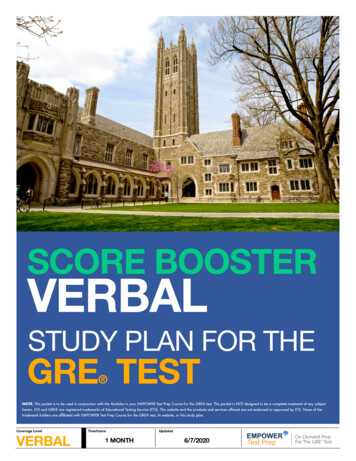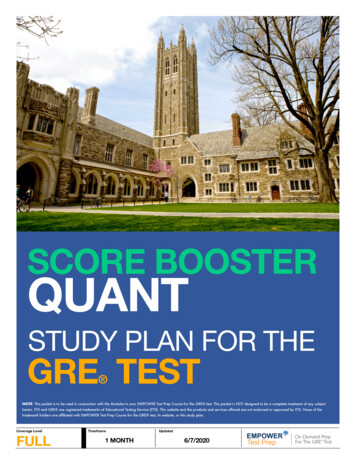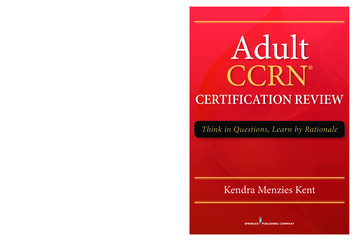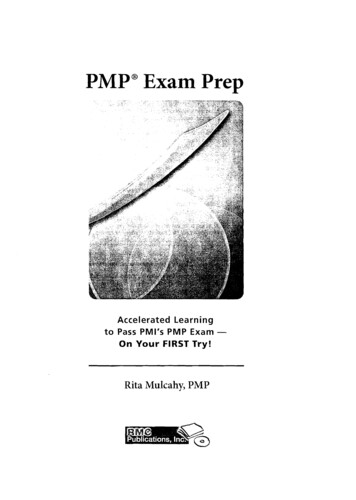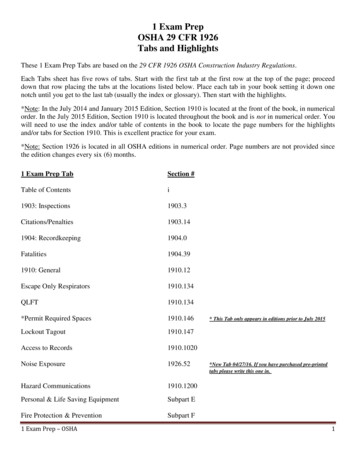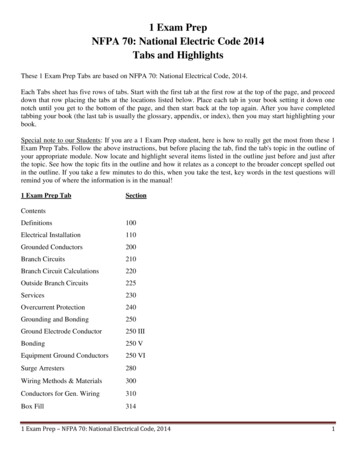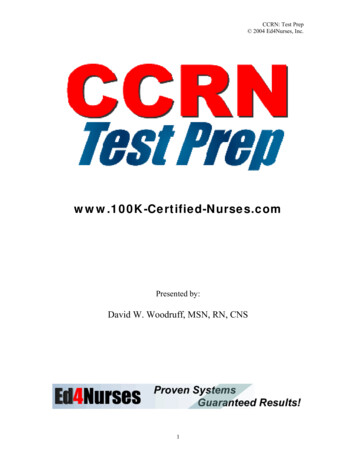
Transcription
CCRN: Test Prep 2004 Ed4Nurses, Inc.www.100K-Certified-Nurses.comPresented by:David W. Woodruff, MSN, RN, CNS1
Checklist for SuccessWe will guarantee your success on the CCRN certificationexam!-- If you study the right things in the right ways -Success Checklist: Attend the entire CCRN: Test Prep program (or use the entire A/V package). Study 5 hours per week for 90 days using the handout, pocket study guide, and flashcards. Listen to all of the audio CDs or watch all of the video-enhanced CDROMs. Identify areas of weakness that need additional study. Review the audio CDs (or CDROMs) of the topics you identified as requiring additional study. Participate in the Nurses’ Success Network on-line study groups and post at leastone comment or question per week.Login at: www.Nurses-Success-Network.comUser: ccrnPassword: excellence Achieve a passing grade of at least 80% on the “Challenge Exam” on-line at theNurses’ Success Network. Use the on-line resources recommended in the “Challenge Exam” results.The CCRN: Test Prep is a 90-day program to guarantee your success on the certification exam. You must use this program and take the exam within 90 days of registering for the guarantee for us to assure your success.Register for the guarantee on-line at :www.Nurses-Success-Network.com
CCRN: Test Prep 2004 Ed4Nurses, Inc.CCRN: Test PrepDescription:This unique two-day program presents the content of the CCRN exam in aquestion and answer format. By the conclusion of the program the participant will haveanswered 150 questions in the format and distribution of the actual exam. In-depthexplanations will be presented for rationale behind correct and incorrect answers, alongwith the theoretical underpinnings of essential concepts.This unique, informative and fun seminar is perfect for CCRN preparation, or acomprehensive critical care review.Objectives:1. Examine strategies for successful completion of the CCRN exam.2. Describe common hematologic and immunologic dysfunction in the critical carepatient.3. Describe the process of coagulopathy in DIC.4. Compare and contrast common GI disorders.5. Plan care for the patient suffering from abdominal trauma.6. Compare and contrast septic, hypovolemic, and cardiogenic shock.7. Describe hemodynamic changes that occur with shock.8. Plan care for patients with cardiopulmonary disorders.9. Compare and contrast acute and chronic renal failure.10. Describe clinical symptoms of electrolyte disturbances.11. Plan care for patients with electrolyte and water emergencies.12. Explain the benefits of several treatment options for acute respiratory failure.13. Plan care for patients with respiratory disorders.14. Describe a simple assessment plan for patients with increased intracranial pressure.15. Evaluate nursing interventions for increased intracranial pressure.16. Describe common endocrine dysfunctions in the critical care patient.17. Compare and contrast diabetic ketoacidosis and hyperosmolar, hyperglycemicsyndrome.18. Define professional and ethical nursing care using AACN definitions.All content in CCRN: Test Prep is 2004 by Ed4Nurses, Inc. and all rights are reserved.Copying or distribution in any form is strictly prohibited by US copyright law.2
CCRN: Test Prep 2004 Ed4Nurses, Inc.DAY 18:00 Introduction and Test Overview8:30 Hematologic / Immunologic (3%)A&P Blood Products & PlasmaOrgan TransplantationLife-threatening coagulopathiesImmunosuppression-AcquiredSickle Cell Crisis9:45 Break10:00 Gastrointestinal (6%)GI BleedHepatic FailureAcute PancreatitisBowel infarction/obstruction/perforationAbdominal Trauma11:30 Multisystem (8%)Sepsis / Septic Shock / MODSToxic IngestionsToxic Exposures12:00 Lunch1:00 Multisystem (con’t)1:30 Cardiovascular (32%)Acute Coronary SyndromesCardiac Inflammatory DiseaseConduction System DefectsAcute Heart Failure & Pulmonary EdemaAortic AneurysmPericarditis2:15 Break2:30 Cardiovascular (continued)Cardiac TraumaHypertensive CrisisShock4:30 Adjourn3
CCRN: Test Prep 2004 Ed4Nurses, Inc.DAY 28:00 Renal (5%)Acute & Chronic Renal FailureRenal TraumaElectrolyte Imbalances9:00 Pulmonary (17%)Acute Respiratory FailurePulmonary Pharmacology9:45 Break10:00 Pulmonary (con’t)ARDSPneumoniaPulmonary Embolus, Fat EmbolusAsthma / COPDChronic Lung DiseaseThoracic Trauma / Thoracic Surgery12:00 Lunch1:00 Neurologic (5%)AneurysmEncephalopathyStroke (ischemic, hemorrhagic)Intracranial HemorrhageSeizuresHead TraumaNeurosurgery / ICP Monitoring2:00 Break2:15 Endocrine (4%)Diabetes InsipidusDiabetes Ketoacidosis & Hyperosmolar ComaAcute HypoglycemiaHormones and Endocrine A&P3:00 Professional Caring and Ethical Practice (20%)AdvocacyCollaborationCaring Practice4:00 Adjourn4
CCRN: Test Prep 2004 Ed4Nurses, Inc.Today’s speaker:David W. Woodruff, MSN, RN, CNSDavid began his healthcare career as a paramedic. After yearsof treating patients “in the field”, David obtained his nursingdegree. His extensive experience includes trauma nursing at alevel-I trauma center, and staff positions in Neurological,Coronary, Medical and Surgical Intensive Care Units. Davidholds a Master’s degree in Adult Health nursing and is aClinical Nurse Specialist in Critical Care Nursing. He is amember of AACN, The Society of Critical Care Medicine, andSigma Theta Tau. He has served as an Instructor of Nursing,Unit Manager, Nursing Expert Witness, and President of aprivate nursing consulting firm. David presents seminarsthroughout the country on a variety of topics including critical care and medical-surgicalnursing, and has published articles in Nursing, RN, and Image. He is widely regarded asa knowledgeable and thorough instructor who can make even the most difficult contentmaterial understandable.I would be happy to hear from you and answer any additional questions you may have.Feel free to contact me at:Phone: (330) 467-2629e-mail: askdavid@ed4nurses.comweb: www.ed4nurses.com5
CCRN: Test Prep 2004 Ed4Nurses, Inc.Introduction and Test Overview1. Why Become Certified?A study conducted by the Nursing Credentialing Research Coalition found thatcertification has a profound impact on the personal, professional and practiceoutcomes of certified nurses. Overall, nurses in the study stated that certificationenabled them to experience fewer adverse events and errors in patient care thanbefore they were certified. Additional results revealed that certified nurses: expressed more confidence in detecting early signs of complications;reported more personal growth and job satisfaction;believed they were viewed as credible providers;received high patient satisfaction ratings;reported more effective communication and collaboration with otherhealth care providers; andexperienced fewer disciplinary events and work-related injuries.2. What is “CCRN”?a. Registered service mark of AACN.b. Credential for certified critical care nurses.3. What to Expect from “The Test”AACN – Certification CorporationFees: 300 non-member 220 member of AACNTest dates: Year-roundRequirements: RN license1750 hours of clinical experience withacute and critical care patients within theprevious 2 years (875 within the past year).If you join AACN ( 78 fee) at the time you register, youpay 298 and get member benefits.Exam is computer-based, 150 questions, with a 3-hour time limitPaper-based testing is offered at the NTICertification is for 3 years.Recertification can be by CERPs or re-testing.Cost of recertification is: 250 non-member, 170 member6
CCRN: Test Prep 2004 Ed4Nurses, Inc.4. Testing Dates, Places and TimesAACN Certification Corporation101 ColumbiaAliso Viejo,CA 92656-4109Phone: (800) 899-2226E-mail: certcorp@aacn.orgWeb: www.certcorp.orgApplied Measurement Professionals Inc. (AMP)8310 Nieman RoadLenexa, KS 66214-1579Phone: (800) 345-6559Fax: (913) 541-0156Business Hours: 8:30 am - 5:00 pm CST Monday-FridayE-mail: info@goamp.comWeb: http://www.goamp.com/Over 100 testing centers nationwide5. What to bring with you:a. Photo IDi. Driver’s licenseii. State ID cardiii. Military ID cardb. Second ID without photoc. Do not bring any personal items with youd.Please Note:This is a focused 90-day program designed to assure your success on the ANCC MedSurg certification exam. You must register for the guarantee and complete the“Certification Checklist” within 90 days to be eligible for the guarantee.You can do this!9 If you are qualified9 And you study the right stuff in the right way9 You will pass!I guarantee it!7
CCRN: Test Prep 2004 Ed4Nurses, Inc.Hematologic / Immunologic (3%) 4 questions1. The nurse is caring for a 32-year-old experiencing organ rejection after a kidneytransplant. Which of the following signs will the patient exhibit?a. Decreased BUN/Creatinineb. Increased transaminase levelc. Increased urine outputd. Increased BUN/Creatinine2. A primary chemical mediator in anaphylactic reaction is?a. Myocardial Depressant Factorb. Histaminec. Complementd. Interferon3. Which of the following laboratory diagnostic findings will most likely be seen inDIC?a. PT and PTT prolongedb. Fibrinogen increasedc. Platelet count increasedd. D-dimer normal4. The beneficial effects of heparin in DIC are thought to be due to its:a. Stimulating effect on platelet manufactureb. Neutralizing of free-circulating thrombinc. Antifibrinolysin activityd. Inhibition of platelet factor XII release8
CCRN: Test Prep 2004 Ed4Nurses, Inc.Hematology1. Functions:a. Medium for transport of O2 and CO2 and nutritientsb. Maintains hemostatsisc. Maintains internal environmentd. Immunee. Inflammationf. Stress Responsei. Impaired skin barrier or irritated mucous membraneii. Impaired gag, cough or swallowiii. Increased gastric pH, colonization aspirationiv. Acute Stress Reactions1. Catabolism2. Decreased healing3. Inhibit immune response4. Inflammatory Responseg. Hemostasisi. Termination of bleedingii. Vascular responseiii. Platelet responseiv. Coagulation1. Platelets2. Thrombocytopenia3. HITT responseDisseminated Intravascular Coagulation (DIC)1. Definition2. Factors TriggeringDIC3. Etiology:a. Bleedingb. Traumac. Sepsisd. AbruptoPlacenta9
CCRN: Test Prep 2004 Ed4Nurses, Inc.4. Clinical Presentationa. Bleedingb. Signs of Thrombosisc. Clinical Presentationi. Petechiaeii. Ecchymosisiii. Purpurad. Labs in DICi. Plateletsii. PTTiii. PTiv. Fibrinogenv. FDP/FSPvi. D-dimervii. Antithrombin III5. Medical Managementa. Maintain ABC’sb. Careful or oral and mucosal bleedingc. Treat stimulid. Correct hypovolemia, hypotension, hypoxia, and acidosise. Stop microclotting to maintain perfusionf. Stop Bleedingg. Stop Thrombosish. Administer IV Heparini. Plasmapheresisj. Nursing Managementk. Nursing Care of the Bleeding Patientl. Blood Productsi. Risks of transfusionii. PRBC’siii. Plateletsiv. FFPv. Cryoprecipitatevi. Adverse Reactions6. Complications of DICa. Mortalityb. Hypovolemic Shockc. Acute Renal Failured. Infectione. Acute Respiratory Distress Syndromef. Strokeg. GI dysfunction10
CCRN: Test Prep 2004 Ed4Nurses, Inc.7. Nursinga. Administer Vitamin K and Folic Acidb. Treat Ischemic Painc. Maintain skin integrityAcquired Immunodeficiency Syndrome (AIDS)1. Etiologya. HIV, CD4 retrovirusb. High-risk groupsi. High-risk sexual behaviorii. Infected sex partnersiii. IV drug usersiv. Recipients of blood products before 1985c. Pathophysiologyi. Invasion and destruction of T4 (helper) cellsii. Incubation 6 months to 10 yearsiii. Decreased immune responseiv. Opportunistic infection2. General principles for managementa. Universal precautionsb. Protect from infectionc. Inflammatory response will be mutedTransplantationCriteria for organ transplantation1. Recipient criteriaa. End-stage organ diseaseb. Absence of:i. Infectionii. Malignancyiii. Other failing organsiv. Substance abuse1. Donor criteriaa. Free of sepsis, cancer, prolonged hypotensionb. Free of communicable disease11
CCRN: Test Prep 2004 Ed4Nurses, Inc.Anti-rejection medicationsDrugCorticosteriodsMajor Effects InflammationCyclosporine Immune andinflammatory responsesATgam(antithymocyteglobulin)Imuran (azathioprine)Reduces T-cell productionOKT3 (muromonab-CD3)Alters T-cell recognition ofantigensPrograf (tacrolimus) Inflammatory responseCellCept (mycophenolate) Immune response Immune response1. General patient carea. Support transplanted organi. Heart Transplantii. Lungiii. Liveriv. Pancreasv.Kidneyb. Watch for signs of infectioni. May be due to immune response12Side Effects Risk of infectionGI bleedHyperglycemiaAdrenal suppressionPotentiates yHyperkalemiaHypomagnesemia Risk of infectionThrombocytopenia Risk of infectionOral and gastric erosionHepatotoxicity Risk of infectionSymptoms of infection WBC, platelet levelsGI distressHTN, chest toxicityGI distress WBC, platelet levelsHypertensionHypokalemia
CCRN: Test Prep 2004 Ed4Nurses, Inc.Leukemia’sAcuteAcute Lymphocytic (ALL)IncidenceAge 2-4Acute Myelogenous (AML)Age 12-20ChronicChronic Lymphocytic (CLL)IncidenceAge 50-70Chronic Myelogenous (CML)Age 30-50CharacteristicsAnemia, Bleeding, Infection, RBC,H&H, WBC, Joint and bone painCharacteristics WBC, RBC, Enlarged spleen,Hepatomegaly, Swollen glandsa. Diagnosticsi. Bone marrow aspirationb. Treatmentii. Chemotherapyiii. Stem cell transplantiv. Transfusion3. Multiple Myelomaa. Plasma cells invade bone marrow, and lymph systemb. Bones become weak and painfulc. Diagnosticsi. X-raysii. Bone marrow aspirationiii. Hypercalcemiad. Treatmenti. Chemotherapyii. Interferoniii. Bone marrow transplantationiv. Plasmapheresisv. Management of Hypercalcemia4. Non-Hodgkin’s Lymphomaa. Malignant neoplasm of the lymphatic systemb. Results in overgrowth of premature and ineffective cellsc. Diagnosticsi. Fever, swollen glands, night sweats, weight lossd. Treatmenti. Chemotherapyii. Radiation therapyiii. Stem cell transplant13
CCRN: Test Prep 2004 Ed4Nurses, Inc.Sickle-Cell Crisis1. Etiologya. More common in black malesb. Presence of Hemoglobin S2. Precipitating factorsa. Dehydrationb. Stress or strenuous exercisec. Infectiond. Fevere. Bleedingf. Acidosisg. Hypoxia (smoking)h. Cold weatheri. Pregnancy3. Presentationa. Bone crisisi. Long bone painb. Acute chest syndromei. Chest painii. Dyspneaiii. Tachycardiaiv. Bloody sputumv. Pulmonary fibrosisc. Abdominal crisisi. Sudden, constant abdominal painii. Not usually associated with N/V/Dd. Joint crisisi. Stiff, painful jointse. Jaundice, bruising, blood in urine may occur with any4. Managementa. Oxygenb. Fluidsc. Folic acidd. Hydroxyurea (Hydrea)e. Pain controli. Mild: Tylenol or NSAIDsii. Moderate: Codeine, Oxycodoneiii. Severe: Morphine, Dilaudidf. Transfusion5. Complicationsa. Renal dysfunctionb. Strokec. Blindnessd. Infection (spleen becomes clogged)14
CCRN: Test Prep 2004 Ed4Nurses, Inc.Gastrointestinal (6%) 9 questions1. Nursing interventions for the patient with hepatic failure include:a. Restrict protein in dietb. Avoid use of narcotics, sedatives and tranquilizersc. Administer lactulose and neomycind. All the above2. The most common cause of upper GI bleeding is:a. Peptic ulcer diseaseb. Esophageal varicesc. AV malformationd. Gastric tumor3. Octreotide is often used to control bleeding from esophageal varices. Theprimary action of Octreotide is to:a. Increase platelet aggregationb. Increase clotting factorsc. Decrease venous returnd. Decrease blood flow4. The administration of vasopressin should be most carefully monitored in patientswho have:a. Diabetes Insipidusb. Coronary artery diseasec. Hypotension secondary to GI bleedd. Diabetes Mellitus5. The inability of the liver to conjugate what substance is the primary contributor tohepatic coma?a. Ammoniab. Ureac. Fatty Acidsd. Bilirubin6. Ecchymosis around the umbilicus indicative of peritoneal bleeding is calleda. Chvostek’s signb. Grey Turner’s signc. Cullen’s signd. Trousseau’s sign15
CCRN: Test Prep 2004 Ed4Nurses, Inc.7. Pulmonary complications of acute pancreatitis may include:a. Adult Respiratory Distress Syndromeb. Elevation of the diaphragm and bilateral basilar ralesc. Atelectasis, especially of the left based. All of the above8. Which of the following laboratory findings is most specific for pancreatitis?a. Leukocytosisb. Elevated serum and urinary amylasec. Hyperglycemia and hypokalemiad. Decreased serum albumin and total protein9. Another diagnostic finding seen in the patient with pancreatitis would include:a. Increased Hctb. Hypocalcemiac. Hyperalbuminemiad. Decreased potassium16
CCRN: Test Prep 2004 Ed4Nurses, Inc.GI BleedEtiology:1. Peptic Ulcer Disease (55%)2. Esophageal varices (14%)3. Arteriovenous malformations (6%)4. Mallory-Weiss tears (5%)5. Tumors & erosions (4% each)6. Other (12%)H. Pylori infection orNSAID use is responsiblefor 98% of upper GIbleeds.DrugCaffeineVasopressorsASA, alcohol, indomethacin, steroidsCorticosteroidsChemotherapy, steroidsMechanism of injury acid production mucosal blood flowH back diffusion mucous secretion cell renewalPrevention:1. Helicobacter pyloria. Pathogenesisi. Transmitted by fecal-oral routeii. Renders mucosa vulnerable to acid damageiii. Inflammatory responseb. Treatment (80-90% eradication rate)i. Antibioticsii. Antisecretory agent2. NSAIDSa. Affects local and systemic prostaglandin inhibitionb. Majority are uncomplicated and asymptomatic3. Stressa. Common cause of UGI bleeding (1.5% of all ICU pts.)b. Higher mortality than pts. admitted with 1 dx. Of UGI bleedingc. Independent risk factors:i. Respiratory failureii. Coagulopathy17
CCRN: Test Prep 2004 Ed4Nurses, Inc.4. Esophageal varicesa. Secondary to portal hypertensionb. Bleeding stops spontaneously in 50% of casesc. Mortality 70-80% in those who continue bleedingd. Treatmenti. Blood pressure management1. Propanolol, nadololii. Vasopressin, NTGiii. Octreotide1. gastrin production2. Local vasoconstrictioniv. Esophageal balloon tamponade (Blakemore / Linton tubes)v. Injection sclerotherapyvi. Variceal band ligation ( rebleeding rate, mortality)vii. Transjugular intrahepatic portosystemic shunt (TIPS)1. portal pressure2. Complications:a. encephalopathyb. Shunt occlusion and rebleedingc. Shunt migration5. GI prophylaxisa. H2 receptor antagonistsi. Block gastric acid output by blocking histamine receptorsb. Sucralfatei. Inhibits pepsin secretionc. Proton pump inhibitorsi. Inhibits Hydrogen ion formation regardless of source ofstimulationd. risk of pneumonia in mechanically ventilated patients (? risk ofaspiration)Early Detection1. Bloody nasogastric aspirate (10-15% false negative)2. Hemoglobin / Hematocrit3. Melena / occult blood monitoring4. Nausea / vomiting / hyperactive bowel sounds5. Coagulation abnormalities6. Shock7. Risk scoring for intervention:a. Hemoglobinb. Systolic B/Pc. Syncope / melanad. Tachycardiae. Cardiac diseasef. Hepatic disease18
CCRN: Test Prep 2004 Ed4Nurses, Inc.Management of Acute Crises1. ICU admissiona. Aspiration is a major risk with active bleeding2. Management of coagulopathies3. Blood product replacement (most transfusion physicians recommend onlycomponent therapy)a. PRBCs (to HCT of 30)b. FFPc. Platelets4. Hemodynamic supporta. Fluidsb. Vasopressorsc. Monitoring5. Gastric acid reductiona. H2 blockersb. Proton pump inhibitors6. Endoscopya. Diagnostic intervention of choiceb. Allows treatment7. Angiographya. Cauterization8. Surgerya. Gastric resectionb. Shunt surgeryc. Liver transplantationReferences:Cook, D.J., Reeve, B.K., Guyatt, G.H., Heyland, D.K., Griffith, L.E., Buckingham, L.,Tryba, M. (1996). Stress Ulcer Prophylaxis in critically ill patients: Resolving discordantmeta-analyses. JAMA, 275, (4), 308-314.Internet sites:American Gastroenterological Association: www.gastro.orgAmerican College of Gastroenterology: www.acg.gi.orgSociety of Gastroenterology Nurses and Associates: www.sgna.org19
CCRN: Test Prep 2004 Ed4Nurses, Inc.Hepatic Failure1. Etiologya. Viral hepatitisb. Acetaminophen overdosei. Chronic alcohol use increases susceptibilityc. Alpha1-antitrypsin deficiencyd. Autoimmune disease2. Diagnostic testinga. CBCb. PTc. AST / ALTd. Bilirubine. Ammoniaf. Glucoseg. Lactate3. Symptomsa. Jaundiceb. level of consciousnessc. Ascitesd. Hypotension & tachycardia (SIRS)4. Managementa. Supportive:i. ICP: mannitolii. Renal failure: dialysisiii. Coagulopathy: platelets, FFPb. Liver transplantAcute Pancreatitis1. Etiologya. Alcoholismb. Biliary tract diseasec. Drugsi. Thiazidesii. Acetaminopheniii. Tetracyclineiv. Oral contraceptivesd. Infectione. Hyperlipidemia, hypertriclyceridemiaf. Structural abnormalities of bile or pancreatic ducts2. Pathogenesisa. Edemab. Necrosis20
CCRN: Test Prep 2004 Ed4Nurses, Inc.c. Hemorrhaged. Pancreatic enzyme releasee. Inflammationi. Enzymes and toxins enter the peritoneumii. permeability of blood vessels, third spacingiii. Enzymes enter systemic circulation capillary permeabilityiv. Shock from circulating volume3. Symptomsa. Abdominal paini. after eating or alcohol ingestionii. Severe, persistent, penetratingiii. Radiates to back or neckb. Feverc. Nausea / Vomiting without paind. Sweating4. Physical exama. Appears acutely illb. Tachycardia, tachypnea, hypotensionc. temperatured. LUQ abdominal tenderness with guardinge. or absent bowel soundsf. Signs of dehydrationg. Signs of necrosis (50% mortality)i. Grey Turner’s signii. Cullen’s sign5. Hemodynamicsa. preload (CVP, PAOP)b. COc. afterload (SVR)6. Diagnostic testsa. Labsi. Serum and urine amylaseii. Lipaseiii. Amylase:creatinine clearance ratioiv. Glucosev. Calcium 2 to albumin21
CCRN: Test Prep 2004 Ed4Nurses, Inc.Ranson’s CriteriaDuring 1st 24 hours HCT 10% BUN 5mg/dl Ca 8 pO2 60 mmHg Base deficit 4 Fluid sequestration 6L 3 criteria require supportive care 7 are critically ill with close to 100% mortalityOn Admission Age 55 WBC 16 Glucose 200 LDH 350 SGOT 2507. Treatmenta. NPOb. NG drainagei. Does not decrease pancreatic enzyme secretionii. Helpful in managing:1. Vomiting2. Gastric distension3. Ileus4. Aspiration from mental statusc. IV fluidsd. Hemodynamic supporte. Pain reliefi. Demoral or Dilaudidii. Morphine may cause biliary colic or spasms of the sphincter ofOddif. Antibiotics for necrotizing pancreatitisi. Imipenemii. Ciprofloxiniii. Cefotaximeg. TPN nutrition (low lipids)8. Complicationsa. Death from cardiovascular instabilityb. Infectionc. Pseudocysti. Collection of blood, necrotic tissue, inflammatory debrisencapsulated in fibrotic tissued. Hypovolemic shocke. Respiratory failure / ARDSf. Pleural effusiong. Renal failure 2 to hypovolemia22
CCRN: Test Prep 2004 Ed4Nurses, Inc.Bowel infarction1. Pathogenesisa. Acute mesenteric ischemia (AMI)b. Insufficient blood flow due to:i. Arterial occlusionii. Venous occlusioniii. Non-occlusive processes2. Symptomsa. Painb. N/Vc. Bloody diarrhead. Hypovolemiae. Metabolic acidosis3. Diagnostic testsa. Labs:i. H/Hii. Amylaseiii. WBCb. KUBc. CT or MRId. Ultrasounde. Guaiac stools4. Treatmenta. Medicali. Volume replacementii. Correct underlying conditioniii. Improve mesenteric blood flowiv. NG tubev. ATBb. Surgicali. Bowel resectionii. Embolectomyiii. Revascularization5. Complicationsa. Perforationb. Stricturesc. Infection23
CCRN: Test Prep 2004 Ed4Nurses, Inc.Abdominal Trauma1. Esophagusa. Penetrating injury more common than bluntb. Early diagnosis is important, gastric acid erodes tissues, and contaminatesthe woundc. Mortality is as high as 27%, mostly due to infectiond. Areas at risk for injuryi. At the cricoid cartilageii. At the arch of the aortaiii. As it passes through the diaphragme. Manifestationsi. Look for abrasions, contusions, lacerationsii. Painiii. Feveriv. Dysphagiav. Bloody emesisvi. Mediastinal crepitusf. Diagnosisi. CXR, KUBii. Esophagogramg. Treatmenti. NG decompressionii. Surgical repairh. Leaks are common2. Diaphragma. Fairly well protectedb. Most often injured by penetrating trauma of the lower chestc. 15% of patients with stab woundsd. 46% of patients with GSWe. Manifestationsi. Have a high degree of suspicion in pts. with trauma to theabdomen or as high as T4ii. Chest painiii. Dyspneaiv. Peristalsis heard in the chestv. Difficulty passing an NG tubevi. Persistent air leak from a chest tubef. CXRg. Evidence on exploratory laph. Treatmenti. Herniation can occur weeks to years laterii. Therefore, surgical repair is necessaryi. Complicationsi. Intra-abdominal hypertension increases risk of herniation24
CCRN: Test Prep 2004 Ed4Nurses, Inc.3. Stomacha. Most is penetratingb. Accounts for about 19% of abdominal injuriesc. Can result from CPRd. Good prognosis with prompt recognition and treatmente. Manifestationsi. Epigastric pain and tendernessii. Peritonitisiii. Bloody drainage from NGiv. Abdominal free airf. Treatmenti. NG tubeii. Surgical resectioniii. H2-blockersg. Complicationsi. Peritonitisii. Intra-abdominal abscessiii. Gastric fistulaiv. Prolonged healing or breakdown of the repair may result incontamination or hemorrhage4. Liver: size and location make it vulnerable to injurya. Most common abdominal organ to be injuredb. Highest mortality with direct blunt trauma (about 70%) and shotguninjuries: (10-15% from hemorrhage)Liver Injury ScaleGradeI HematomaI LacerationII HematomaInjurySubcapsular, nonexpanding, 10% surface areaCapsular tear, non-bleeding, 1 cm depthSubcapsular, nonexpanding, 10-50% surface areac. Manifestationsi. Have a high degree of suspicion with patients with persistentunexplained hypotensionii. Evidence of peritonitis with bile leakageiii. RUQ pain or tendernessd. CXRe. Diagnostic peritoneal lavage may be helpfulf. CT is preferred, if stableg. Treatmenti. If bleeding is small, serial CT scansii. Liver resection is indicated if:1. Bleeding is extensive, or on-going2. Signs of sepsis25
CCRN: Test Prep 2004 Ed4Nurses, Inc.3. Deterioration of liver function testsh. Complicationsi. Uncontrolled hemorrhageii. Sepsisiii. Decreased albuminiv. Hypoglycemiav. Drug toxicityvi. Bleeding from loss of clotting factorsi. Post-operative follow-upi. Labs:1. Coagulation profile2. Ammonia level3. Liver profile4. Serum protein and glucose5. Replace blood products as neededii. Major complications secondary to liver damage1. Blood loss2. PRBCs, platelets, FFP3. Assess for DIC4. Pulmonary insufficiency5. Atelectasis, pleural effusion, pneumonia are commona. Related to position of the liver, pleural irritation, and pain6. Infection7. Tissue debris, necrosis, bile8. Abscess or sepsis9. Assess for signs of infection10. CT for abscess formation5. Spleen: most commonly injured organ in blunt traumaa. Isolated splenic injury occurs in about 20% of all cases and is associatedwith a very low mortalityb. Overall mortality 11%, with associated injury 25%c. Assessmenti. LUQ injuryii. Pain or tendernessiii. Ballance’s sign: dullness to percussion that disappears withposition changed. Manifestationsi. Graded from I to V depending on injury severityii. KUB may show changes in splenic outlineiii. CT scaniv. Fractures of ribs 8-10 associated with a 20% chance of injuryv. WBC, H/Hvi. Hypovolemia, shock26
CCRN: Test Prep 2004 Ed4Nurses, Inc.e. Treatmenti. Localized bleeding control to preserve spleen, if damage issuperficial and localizedii. Partial splenectomy, when wound is deepiii. Splenectomy, when blood supply is interrupted, spleen isdestroyed, or hemorrhage cannot be stoppedf. Complicationsi. OPSI: Overwhelming Postsplenectomy Infection: due to loss ofimmune actions of the spleenii. Hemorrhageiii. Infection, abscess6. Pancreas: mostly from penetrating woundsa. Associated with multi-organ injuryb. Pancreatic enzymes may not elevate due to inactivation during injuryc. Manifestationsi. Mechanism of injuryii. Epigastric pain & tendernessiii. amylase, lipaseiv. Nausea, vomitingd. Treatmenti. Drainage of enzymesii. Surgical repairiii. Wound drainagee. Complications (due to inadequate drainage during surgery)i. Pseudocystii. Abscess7. Bowela.b.c.d.e.f.g.h.i.Penetrating, blunt or shearing traumaDuodenal and Ileum InjuriesRarely single organ injuriesAlkalinity of contents produces immediate irritationOften difficult to diagnose since contents are sterile, peritonitis does notoccur immediatelyFever, jaundice, bowel obstruction, abdominal pain, edemaGraded I-V by severityOctreotide to decrease secretionsComplicationsi. Sepsis with MODS and duodenal fistula can be lethalThe American Gastroenterological Association: www.gastro.org27
CCRN: Test Prep 2004 Ed4Nurses, Inc.8. Small Bowela. Look for contusions, wounds over abdomenb. Abdominal pain and tendernessc. bowel soundsd. Hypovolemiae. Delayed rupture is possiblef. CT scan, KUB for free airg. Treatment is surgical interventionh. Fluid / nutrition deficiency common post-opi. Fistula formation is possible post-op9. Abdominal assessmenta. Historyi. Prior surgeriesii. Nutritional deficitsiii. Absorption problemsb. Inspectionc. Auscultationd. Percussione. Palpationf. Diagnostic studiesi. X-raysii. CTiii. Arteriographyiv. Diagnostic Peritoneal Lavage10. Intra-abdominal Hypertensiona. Caused by fluid volume resuscitationb. Results in renal dysfunction and respiratory compromisec. Measured in bladder with T-piece catheterd. Hypertension is defined as 18 mmHge. Temporary abdominal closure reduces abdominal pressure and improveslung dynamics, but does not improve renal function or oxygenation.28
CCRN: Test Prep 2004 Ed4Nurses, Inc.GI Surgeries:1. Whipple (Pancreaticoduodenectomy)a. Used for:i. Resectable pancreatic cancerii. Pancreatic canceriii. Chronic pancreatitisb. Removal of:i. Head of the pancreasii. Duodenumiii. Part of the common bile ductiv. Gallbladderv. Sometimes a portion of the stomachc. Complications:i. Peritonitisii. Sepsis, SIRS, MODSiii. Pancreatic fistulaiv. Uncontrolled blood sugar in diabetics2. Esophago-gastrectomya. Used for:i. Esophageal cancerb. R
Sigma Theta Tau. He has served as an Instructor of Nursing, Unit Manager, Nursing Expert Witness, and President of a private nursing consulting firm. David presents seminars throughout the country on a variety of topics including critical care and medical-surgical nursing, and has published articles in

